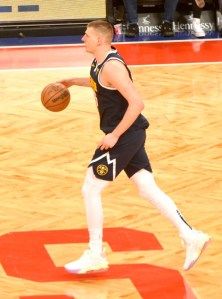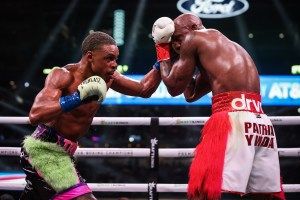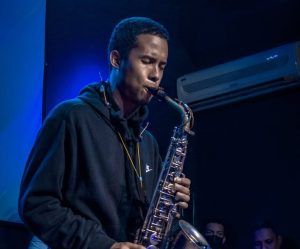Joker and the Nuggets seek their first NBA title facing the Heat

Nikola Jokic was masterful in the Western Conference Finals. The Denver Nuggets center posted averages of 29.9 points, 13.3 rebounds and 10.3 assists in a 4-0 sweep of the Los Angeles Lakers in their best-of-seven series. Now the two-time NBA regular season MVP (2021, 2022) is four wins away from earning his first league championship as well as the first for the franchise.
His quest begins tonight when the Nuggets host the Eastern Conference champion Miami Heat in Game 1 of the National Basketball Association Finals. The Heat arrived there by defeating the Boston Celtics 4-3, ending the series with a 103-84 road victory on Sunday night. The Heat took the first three games before the Celtics stormed back to even the series and attempted to become the only team in NBA history to win a best-of-seven series after being down 0-3.
Jokic and the Nuggets were the No. 1 seed in the West entering the playoffs and knocked off the No. 8 seed Minnesota Timberwolves 4-1 in the opening round and dismissed the No. 4 seed Phoenix Suns 4-2 in the conference semifinals before sweeping the Lakers. The Heat, only the second No. 8 seed to make it to the NBA championship, 24 years after the New York Knicks became the first in 1999, are giant killers.
RELATED: The Nuggets head to the Finals while the Celtics hang on versus the Heat
They eliminated the No. 1 seed Milwaukee Bucks––who had the league’s best regular season record at 58-24––in five games to start their postseason run. The Heat then sent the No. 5 seed New York Knicks packing 4-2 prior to their compelling series against the No. 2 seed Celtics. But Jokic, nicknamed Joker, and the Nuggets are looking to put an end to the Heat’s unforeseen playoff success.
The team’s share similar traits. Both have superstars in Jokic and the Heat’s stellar small forward Jimmy Butler and complimentary stars. In torching the Lakers, Denver guard Jamal Murray became the first player in NBA history to average at least 30 points per game (he averaged 32.5) on 50 percent shooting from the field, 40 percent on 3-point attempts and 90 percent from the foul line. Murray’s unmatched split was 52.7/40.5/95.
While the Heat’s Bam Adebayo was inconsistent against the Celtics, the 25-year-old forward/center is a two-time All-Star and four-time All-Defensive selection. The Nuggets and Heat have also heavily relied on their role players who have emerged as invaluable this postseason. Denver head coach Mike Malone and Miami’s Eric Spolestra, who currently is arguably the best in his profession and one of the most accomplished NBA head coaches ever, have shaped cohesive, symbiotic rosters.
“If you’re going to win at a high level, you can’t have distractions,” said Malone via the Associated Press ahead of the Finals. “You have to have guys that get along—on the court, off the court—and come together and share in a common goal.”
The prediction here is the Nuggets will achieve their goal with a 4-2 series win.
The post Joker and the Nuggets seek their first NBA title facing the Heat appeared first on New York Amsterdam News.
Little Amal, a 12-foot puppet of a Syrian refugee, will stop here in the … – Pittsburgh Post-Gazette
Josh Taylor and Teofimo Lopez to battle June 10 at MSG

Combat sports return to New York City when Josh Taylor (19-0, 13 KOs) defends his WBO and Ring Magazine titles against former lightweight champion Teofimo Lopez (18-1, 13 KOs) Saturday, June 10 at Madison Square Garden’s Theater.
The Brooklyn native Lopez is 7-1 inside Madison Square Garden, suffering his only defeat to George Kambosos Jr. in November 2021, relinquishing his unified titles. Taylor returns to the ring for the first time since February 2022.
“This is a super fight on both sides of the pond, the junior welterweight king in Josh Taylor stepping up against the young, dynamic Teofimo Lopez,” said Top Rank chairman Bob Arum, the fight’s promoter. “I cannot wait for these two supreme talents to step into the Madison Square Garden ring. It’s going to be a special night.”
Puerto Rican rising star and junior middleweight Xander Zayas (15-0, 10 KOs) will challenge Ronald Cruz (18-2-1, 12 KOs) in the co-main event. Look for domination out of Zayas, one of the brightest stars at Top Rank.
Two weeks later at the Garden, Edgar Berlanga (20-0 16 KOs), formerly of Top Rank and now with Matchroom, will face Irishman Jason Quigley (20-2 14 KOs). Berlanga is 4-0 at the Garden.
RELATED: Haney remains undefeated with controversial victory over Lomachenko
“I’m excited to be back in my hometown and to perform at the mecca of boxing once again,” said the Brooklyn native. “I want this night to be historic for my fans and for all the people of Puerto Rico and to witness greatness. I feel like I’m reborn again in the sport, signing with Matchroom and getting back to where it all started with my old coach Marc Farrait. I promise it’ll be something big on June 24.”
Berlanga struggled in his last fight, leading to Top Rank not re-signing him. He hopes to put on a big performance under a new promoter.
In the co-main, Reshat Mati (13-0 7 KOs) will face his toughest opponent to date when he steps in the ring against Adam Kownacki (20-3 15 KOs).
At last, undefeated, unified welterweight champion Errol Spence Jr. and undefeated WBO welterweight champion Terence Crawford both posted to social media that they have agreed to a battle on Saturday, July 29, 2023, at T-Mobile Arena in Las Vegas, Nevada.
The post Josh Taylor and Teofimo Lopez to battle June 10 at MSG appeared first on New York Amsterdam News.
Go With The Flo – Amsterdam News
Go With The Flo Amsterdam News
Rideshare workers say don’t tax us twice

Rideshare workers are urging Gov. Kathy Hochul and the MTA to refrain from imposing what they deem as a double tax on them and their jobs.
The Independent Drivers Guild (IDG), which says it represents many of the city’s rideshare drivers (as well as drivers in New Jersey, Connecticut, Illinois, Massachusetts, and Florida), plans to rally in front of the governor’s offices in Manhattan on Friday, June 2. They plan to deliver a petition that calls on Hochul to recognize that the proposed Central Business District (CBD) Tolling Program would amount to a second tax on for-hire vehicle (FHV) drivers.
“Please exempt rideshare drivers from the new congestion pricing toll,” the IDG petition said. “For-hire vehicle trips were already assigned a congestion tax of $2.75 per trip by the state legislature in the first phase of congestion pricing. Adding an additional congestion tax or toll as high as $23 per trip will cost thousands of low-income, immigrant rideshare drivers their jobs and it will put rideshare costs out of reach for hardworking New Yorkers who depend on Uber, Lyft and for-hire vehicles to get around.”
The CBD Tolling Program is New York’s attempt to institute an urban congestion pricing plan that would lower traffic congestion and improve air quality in Midtown Manhattan, while increasing revenue for the MTA.
Cars that enter or remain in the CBD during peak hours would be electronically tolled—charged via E-ZPass or have toll bills mailed directly to the home address of the car’s registered owner.
The IDG says this new tax would lead to a decrease of nearly 15,000 FHV driver jobs.
“It’s outrageous and illegal to single out Uber, Lyft, and for-hire vehicle drivers with a second congestion tax. For a for-hire vehicle driver with a typical six days per week schedule, adding this second congestion tax would cost as much as $7,000 per year,” said IDG President Brendan Sexton. “That means the MTA proposes to tax FHV drivers, over 90% of whom are immigrants and people of color, over 15% of their annual take-home pay.
RELATED: Food delivery workers, rideshare drivers demand more rights
“Why would you double-tax the only group that has already been paying congestion tax for years, a group that is also protected under federal law as an economic justice population? If they move forward with this double tax, they could end up with years of delays in court.”
The language of the IDG’s letter to Hochul points out that:
“1) The proposed double taxation of FHV rides is unfair.
“2) Singling out this economic justice community for double taxation is illegal and may lead to years of delays in court.
“3) By targeting rideshare drivers, rather than their passengers, the proposals will fail to reduce congestion in the Central Business District, one of the central goals of the policy.”
An analysis of the CBD Tolling Program by the progressive policy advocacy group the Black Institute (TBI) also determined that the plan would “economically demolish an industry that feeds tens of thousands of New Yorkers who are already struggling.”
“The Black Institute (TBI) felt compelled to assess this issue from the lens of people of color,” TBI said in a report published this past January 2023, entitled “Just Call It a Black and Brown Toll: An analysis of the MTA’s proposed congestion pricing plan.” “While our analysis of the issue pales in length compared to the MTA’s, we have just as much to say about the issue, the EA [environmental assessment], and the MTA as any other.”
The TBI report said the higher costs of driving into Midtown Manhattan will inevitably lead to greater air pollution in parts of Black- and brown-dominated neighborhoods in the Bronx and Harlem, where commuters will begin driving so they can park their cars before hopping onto public transportation and going into the CBD. TBI found that the CBD Tolling Program “in its current form is undoubtedly a regressive tax not because of its uniformity, but by the fact that there is practically no easement whatsoever for lower-income people. Unfortunately, in our city, low income and race happen to go hand in hand…New York is one of the most unequal cities on Earth––despite now only making up around 40% of the city’s population across the five boroughs, white residents disproportionately occupy the city’s highest-paying jobs. They also have a median wage that is over 50% greater than the median wage for Black people, and over 60% greater than the median wage for Hispanic people.”
“FHV drivers are upset. How could the MTA and the governor do something so unfair?” said longtime Uber driver and IDG Organizing Director Aziz Bah. “We’re taking to the streets to fight this unfair and illegal double tax!”
The post Rideshare workers say don’t tax us twice appeared first on New York Amsterdam News.
Malcolm X Day 2023 – Amsterdam News
Malcolm X Day 2023 Amsterdam News
Jazz clubs in NYC

Jazz clubs are secular houses of worship, where audiences gather to witness musicians openly exhibit their emotions, skill, and life experiences. The clubs have their own ambience, dancing in musicians’ unblemished truth. The music swings, it jumps, it might hit you in the gut, but damn—what a hip happening. Call it what you want, good engaging music, all enthralling!
Although Bill’s Place opened in 2006, the brownstone stands in memorial salute to “Swing Street,” that 1920s strip between Lenox and Seventh Avenues where speakeasies in basement joints lined both sides of the street. The joints where Billie Holiday sang her young heart out, Willie “the Lion” Smith performed as house pianist, and Duke Ellington could often be seen just hanging. You are welcome to bring your own brown bag…BYOBB.
Further downtown, Max Gordon opened the Village Vanguard in 1935, where he presented folk music and those beat poetry cats. As time drifted into 1957, it became a jazz house that has since journeyed into a 21st-century jazz mecca.
HARLEM JAZZ CLUBS
Bill’s Place 148 W. 133rd Street (Open Friday–Saturday) 212-281-0777 billsplaceharlem.com
Room 623 Harlem’s Speakeasy Jazz Club 271 W. 119th Street (Open Wednesdays, Fridays, Sundays) 212-589-8979 room623.com
The Shrine 2271 Adam Clayton Powell, Jr. Blvd. (World music, jazz) 212-690-7807 shrinenyc.com
New Amsterdam Musical Association 107 W. 130th Street (Live jazz and open mic, jam on Monday nights) 212-281-1350 namaharlem.wixsite.com
American Legion Post 398 248 W. 132nd Street (Live jazz on Sundays) 212-283-9701 Legion.org
Marjorie Eliot Parlor Entertainment Jazz (Open on Sundays) 555 Edgecombe Ave. 212-781-6595 Harlemonestop.com
Silvana Bistro 300 W. 116th Street (Live jazz and world music) (Downstairs) 646-692-4935 Silvana-nyc.com
Smoke Jazz & Supper club 2751 Broadway 212-864-6662 Smokejazz.com
The Porch 750A St. Nicholas Avenue 646-895-9004 theporchnyc.com
MANHATTAN
Dizzy’s Jazz Club 33 W. 60th Street 212-258-9595 2023Jazz.org
Jazz at Lincoln Center Broadway at 60th Street 212-258-9800 Jazz.org
Django Jazz Club & Restaurant 2 Avenue of the Americas 212-519-6649 Thedjangonyc.com
Birdland Jazz Club 310 W. 44th Street 212-5813080 Birdlandjazz.com
Blue Note Jazz Club 131 W. 3rd Street 212-475-8592 Bluenotejazz.com
The Jazz Gallery 1160 Broadway 5th floor/entrance on 27th Street info@jazzgallery.org
Zinc Bar 82 West 3rd Street 212-477-9462 info@zincjazz.com
The Stone 55 W. 13rd Street (near 6th Avenue) Avant garde jazz (Music Wednesday–Saturday) 917-474-0018 thestonenyc.com
Village Vanguard 178 7th Avenue South 212-255-4037 villagevanguard.com
Mezzrow Jazz Club 163 W.10th Street 646-476-4346 smallslive.com/mezzrow/
Small’s Jazz Club 183 W. 10th Street 646-476-4346 Smallslive.com
Nublu 151 Avenue C (between 9th and 10th Streets) 646-546-5206 Nublu.net
Arthur’s Tavern 57 Grove Street 212-414-4314 Arthurstavern.nyc
BROOKLYN
Sista’s Place 456 Nostrand Avenue 718-398-1766 Sistasplace.org
Orinthology Jazz Club 6 Suydam Street 917-231-4766 Orinthologyjazzclub.com
Bar LunAtico 486 Halsey Street, Bed-Stuy 718-513-0339 Barlunatico.com
Bar Bayeaux 1066 Nostrand Ave 347-533-7845 Barbayeaux.com
Barbes 376 9th Street, Park Slope 347-422-0248 Barbesbrooklyn.com
The Brownstone Jazz 107 Macon Street 917-704-9237 (Open Friday–Sunday) brownstonejazz.business.site
Wilson Live 637 Wilson Avenue wilsonlivebk.com
The post Jazz clubs in NYC appeared first on New York Amsterdam News.
Classical conversations, Part 1

I was onstage with pianist Aaron Diehl, his trio, and the Milwaukee Symphony Orchestra when the New York Amsterdam News reached out and asked me to pen a piece celebrating classical music for June’s special Black Music Month issue. We were rehearsing the vocal solo in Mary Lou Williams’s “Zodiac Suite” and I could not turn down an opportunity to highlight the music Williams herself had worked so hard to wrangle. Classical music offered her an expanded palette with which to create!
A Harlem resident like me, Williams’s famous performances at Café Society and Minton’s Playhouse and the salon she hosted in her apartment on Hamilton Terrace motivated and inspired the likes of Bud Powell and Thelonious Monk. She invited the world in and made it all her stage. In her honor, I celebrate Black Music Month with you as I explore Black music that embraces the notion of this classical palette.
I spoke with composer George Lewis, artistic director of the International Contemporary Ensemble, professor of American music and chair in composition at Columbia University, and co-editor of the upcoming ”Composing While Black.”
“Classical music today is undergoing a stylistic explosion in which nobody really knows where the music is going…but you don’t have to check your culture at the door when you enter the classical realm.”
Lewis, also a sage historian, pioneered the real-time improvisation of computer programs with humans, engaging the past and tempting the future. Lewis’s classic composition “North Star Boogaloo” placed a live “classical” percussionist into pre-recorded samples of basketball legends “rapping” and poetry read by Quincy Troupe, in his take on hip-hop.
As composer Tania León has said, “Who gets to be on the stage?” is part of the story of Black classical music. Lewis and musicians like Olly Wilson who created electronically expanded the mediums through which an invitation could be extended.
“It’s time to celebrate the Black classical composer as part of Black music,” Lewis said, especially those “living and breathing: Nkeiru Okoye, Carlos Simon, Tania León, Marcos Balter, Trevor Weston, Alvin Singleton, Jeffrey Mumford, T. J. Anderson, Allison Loggins-Hull, Anthony Davis, Jonathan Bailey Holland, Andile Khumalo, Renée Baker, Anthony R. Green, Camae Ayewa, Shelley Washington, Kennedy Dixon, Yaz Lancaster, Leila Adu-Gilmore, Brittany J. Green, Alyssa Regent, Nyokabi Kariuki, Daijana Wallace, Nathalie Joachim, Corie Rose Soumah, Darian Donovan Thomas, Njuabulo Phungula, Tyondai Braxton, Elliott Reed, Mikhail Johnson, and many others, blazing new and influential trails.”
I asked Tania León about this moment. She is a composer, conductor, professor emeritus of Brooklyn College, Pulitzer Prize winner; an advisor to arts organizations; and the founder of Composers Now, a nonprofit uplifting “creatives making an impact in all styles of music right now.”
She won a Kennedy Center Honor last year and honorary doctorates from Brooklyn College, New Jersey City University, and Columbia University, as well as NYU’s Dorothy Height Award this year.
“There is a piece in my catalog from the 1980s that is now a classic. That piece is now a grandmother. But this act of discovery? This story is an act of repetition: who gets the stage.”
Going back in the archives—hers are now housed at Columbia University—is to observe a natural history of classical music in New York City. Flashback to the 1970s and a young hip trio of composers—Tania León, Julius Eastman, and Talib Hakim—are staging classical music concerts with the Brooklyn Philharmonic in hospitals, public parks, and churches. Guest stars include seminal artists and torchbearers such as Eubie Blake, Tito Puente, and Betty Carter, and the group is pivotal in launching the U.S. careers of Chinese composers like Bright Sheng and Tan Dun.
It’s bittersweet to contemplate the recent renaissance of the late Eastman, the avant-garde composer, pianist, vocalist and performer, when “in 1977, he was just walking the streets of New York,” León said. In a process of making without fear, experimental music does often become, over time, the next classical expression. Perhaps for this reason, visionaries flock to León’s inexhaustive talents. Extraordinary collaborations—with the choreographers Arthur Mitchell and Geoffrey Holder, writers Rita Dove and Wole Soyinka, the composers she’s mentored over a lifetime as an educator, and—of course—institutions including Los Angeles Philharmonic and the New York Philharmonic, and hundreds of others.
“What is the difference between the waltz and the mambo?” she asks, and means it. “These kinds of demarcations are being challenged, erased. These are just dances; these represent the different cultures of the world.”
She told NPR in 2022, “If you are compelled [to compose], it’s because you feel that you have something to say in the world of sound. When you study the early works of any composer, there are traces that grow into the later composition —you find the seeds there. So if you as a student want to get into this…pay attention to what you’re doing from the very beginning.”
The sumptuous, rhythmic compositions that emanate from her nimble pencil (she writes by hand) graft color and culture into virtuosic musical lines, but every player has to bring their own humanity to the table.
Alison Buchanan’s voice towered inside my television and caught me off guard.
I thought my Netflix had skipped to PBS as “Dido’s Lament” by 17th-century’s Purcell poured forth, but it was the international soprano and artistic director of UK’s Pegasus Opera singing to Queen Charlotte in “Bridgerton.”
Buchanan’s scene in the Shonda Rhimes series, was filmed at London’s historic Hackney Empire theater in a neighborhood with a large Black population and the programming—including this filming—reflects that.
“Classical music is the pathway to my soul,” said Buchanan, who now mentors young Black singers and provides opportunities through her opera company. “I grew up inside that West Indian [context of] ‘children should be seen and not heard.’ When I was at school, I never felt I had a voice, but when I started to sing, I suddenly felt able to express what I could not verbalize” in speaking.
And I can relate. After spending my early childhood years in New York City, we moved to quiet Connecticut when I was ready for grade school, and birds and locusts were the loudest players. I was constantly urged not to be so loud. Summer stock theater and chorus became my acoustic safe zone.When I went to college in Harlem, I began a slow process of unlocking my natural, fuller voice, which led me down pathways I still travel. The opening of Voice creates its own sonic boom.
We discussed the impact of Buchanan’s televised, regal poise, “a noble posture, we call it,” she said. Shoulders alive, ribcage gently lifted, eyes lit from within, cheekbones radiating, breastbone proud.
“I enjoy the feeling within me, the way the high voice vibrates inside when it’s balanced and open.”
Singing asks us to be the bell of our own horn, the body of our own cello. We know the stereotype: “Opera singer shatters glass with astronomically high note!” The laser power of a vibrating head-voice is necessary to the image of the Black singer as a trumpet for freedom. Think Marian Anderson on the steps of the Lincoln Memorial in 1939, in concert with the United States of America. Think Mahalia Jackson live at the Newport Jazz Festival, singing the songs of former slaves to Duke Ellington’s horns. Think voices facing into the headwinds.
Next week: Part 2.
Alicia Hall Moran is a Harlem resident, classical mezzo soprano, and conceptual vocal artist, and former AmNews classical music columnist for “Suite Sounds.”
*Dedicated in loving memory of Raul Abdul.
The post Classical conversations, Part 1 appeared first on New York Amsterdam News.




